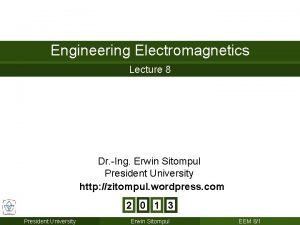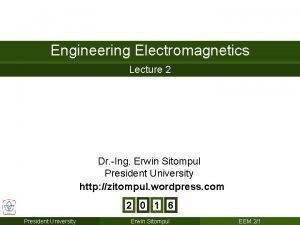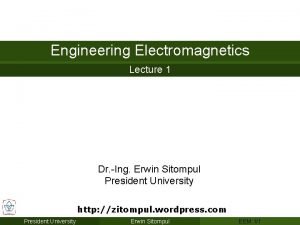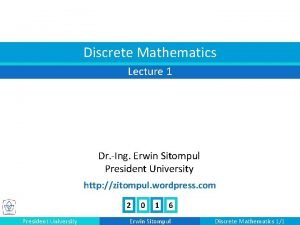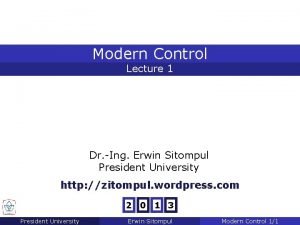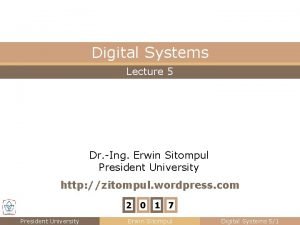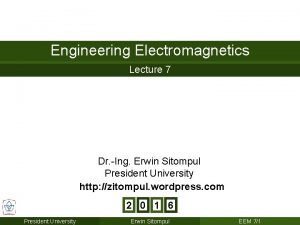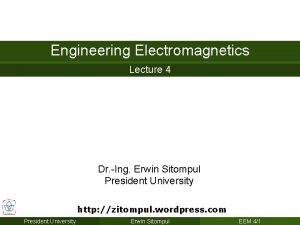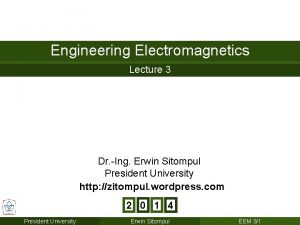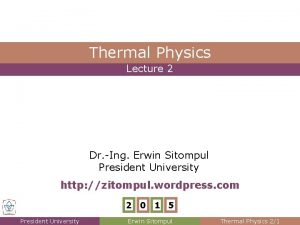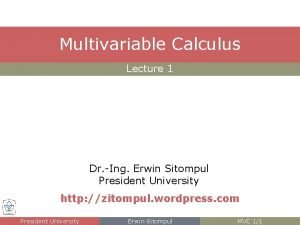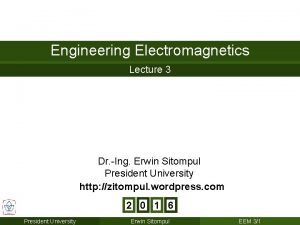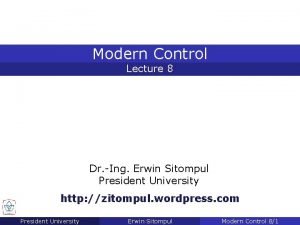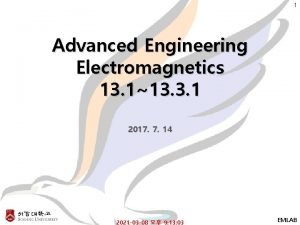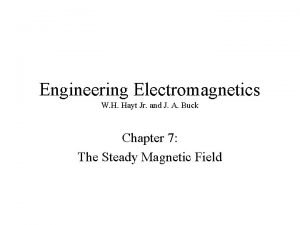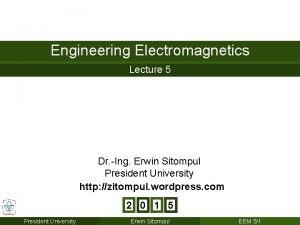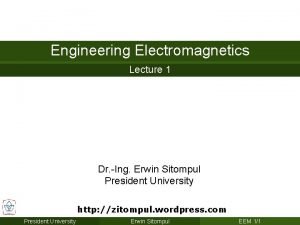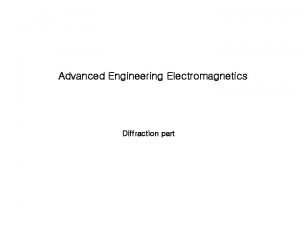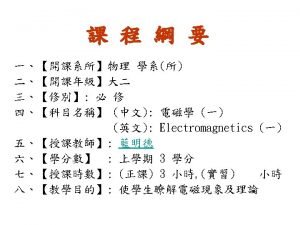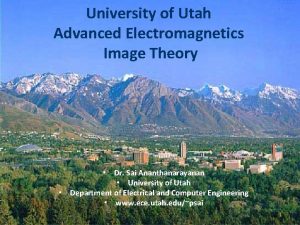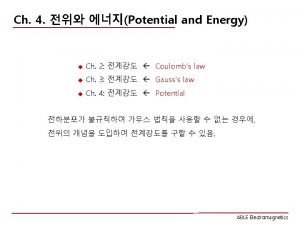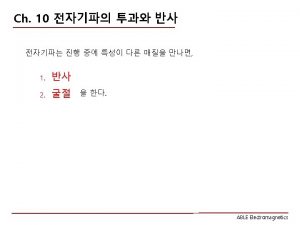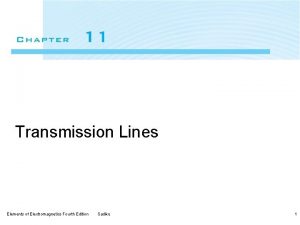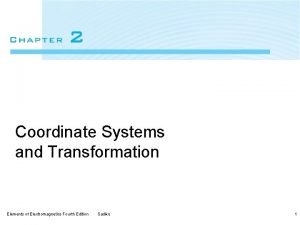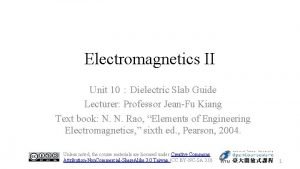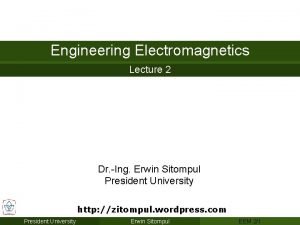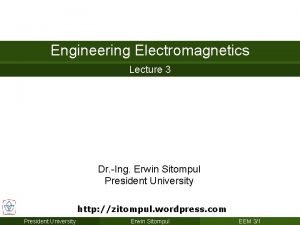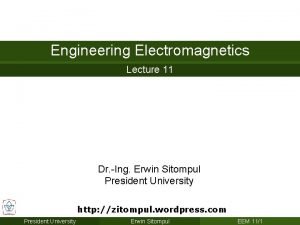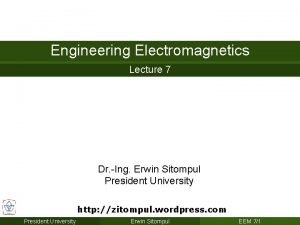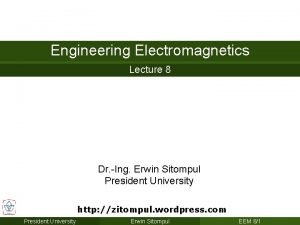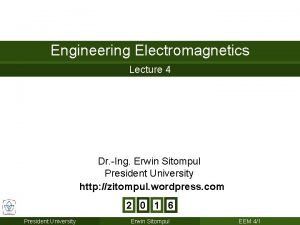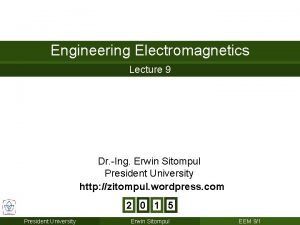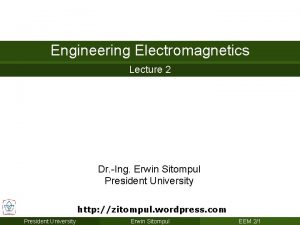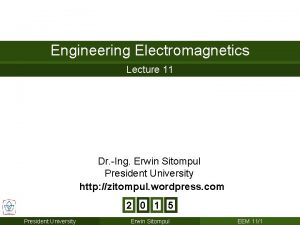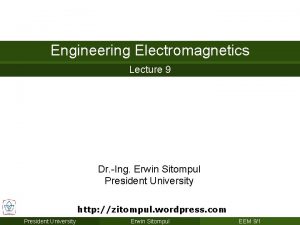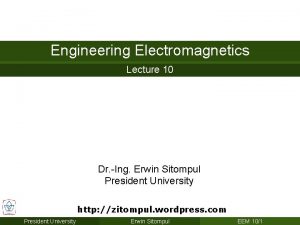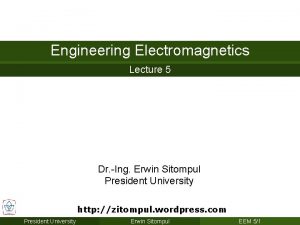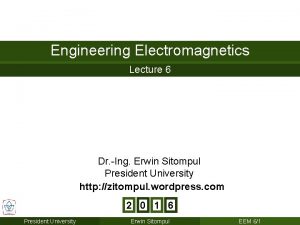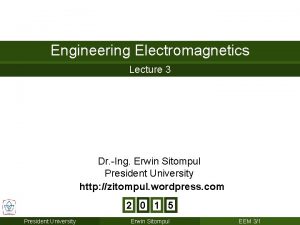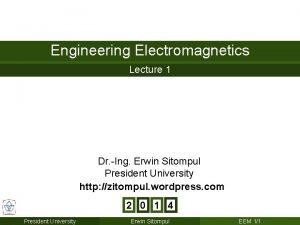Engineering Electromagnetics Lecture 7 Dr Ing Erwin Sitompul

























- Slides: 25

Engineering Electromagnetics Lecture 7 Dr. -Ing. Erwin Sitompul President University http: //zitompul. wordpress. com 2 0 1 6 President University Erwin Sitompul EEM 7/1

Engineering Electromagnetics Chapter 5 Current and Conductors President University Erwin Sitompul EEM 7/2

Chapter 5 Current and Conductors Current and Current Density n Electric charges in motion constitute a current. n The unit of current is the ampere (A), defined as a rate of movement of charge passing a given reference point (or crossing a given reference plane). n Current is defined as the motion of positive charges, although conduction in metals takes place through the motion of electrons. n A new quantity, current density J is defined. It is measured in amperes per square meter (A/m 2). President University Erwin Sitompul EEM 7/3

Chapter 5 Current and Conductors Current and Current Density n The increment of current ΔI crossing an incremental surface ΔS normal to the current density is: n If the current density is not perpendicular to the surface, n Through integration, the total current is obtained: President University Erwin Sitompul EEM 7/4

Chapter 5 Current and Conductors Current and Current Density n Current density may be related to the velocity of volume charge density at a point. • An element of charge ΔQ = ρvΔSΔL moves along the x axis • In the time interval Δt, the element of charge has moved a distance Δx • The charge moving through a reference plane perpendicular to the direction of motion is ΔQ = ρvΔSΔx President University Erwin Sitompul EEM 7/5

Chapter 5 Current and Conductors Current and Current Density n The limit of the moving charge with respect to time is: n In terms of current density, we find: n This last result shows clearly that charge in motion constitutes a current. We name it here convection current. n J = ρvv is then called convection current density. President University Erwin Sitompul EEM 7/6

Chapter 5 Current and Conductors Continuity of Current n The principle of conservation of charge: “Charges can be neither created nor destroyed. ” n But, equal amounts of positive and negative charge (pair of charges) may be simultaneously created (obtained) by separation or destroyed (lost) by recombination. • The Continuity Equation in Closed Surface n Any outward flow of positive charge must be balanced by a decrease of positive charge (or perhaps an increase of negative charge) within the closed surface. n If the charge inside the closed surface is denoted by Qi, then the rate of decrease is –d. Qi/dt and the principle of conservation of charge requires: • The Integral Form of the Continuity Equation President University Erwin Sitompul EEM 7/7

Chapter 5 Current and Conductors Continuity of Current n The differential form (or point form) of the continuity equation is obtained by using the divergence theorem: n We next represent Qi by the volume integral of ρv: n If we keep the surface (and thus the enclosed volume) constant, the derivative becomes a partial derivative, • The Differential Form (Point Form) of the Continuity Equation President University Erwin Sitompul EEM 7/8

Chapter 5 Current and Conductors Continuity of Current n Example The current density is given by . • Total outward current at time instant t = 1 s and r = 5 m. • Total outward current at time instant t = 1 s and r = 6 m. • Finding volume charge density: President University Erwin Sitompul EEM 7/9

Chapter 5 Current and Conductors Metallic Conductors Reading Only n The energy-band structure of three types of materials at 0 K is shown as follows: n Energy in the form of heat, light, or an electric field may raise the energy of the electrons of the valence band, and in sufficient amount they will be excited and jump the energy gap into the conduction band. President University Erwin Sitompul EEM 7/10

Chapter 5 Current and Conductors Metallic Conductors Reading Only n First let us consider the conductor. n Here, the valence electrons (or free conductive electrons) move under the influence of an electric field E. n An electron having a charge Q = –e will experiences a force: n In the crystalline material, the progress of the electron is impeded by collisions with the lattice structure, and a constant average velocity is soon attained. n This velocity vd is termed the drift velocity. It is linearly related to the electric field intensity by the mobility of the electron μe: • The Point Form of Ohm’s Law President University Erwin Sitompul EEM 7/11

Chapter 5 Current and Conductors Metallic Conductors Reading Only n The application of Ohm’s law in point form to a macroscopic region leads to a more familiar form. n Assuming J and E to be uniform, in a cylindrical region shown below, we can write: President University Erwin Sitompul EEM 7/12

Chapter 5 Current and Conductors Conductor Properties and Boundary Conditions n Property 1: The charge density within a conductor is zero (ρv = 0) and the surface charge density resides on the exterior surface. n Property 2: In static conditions, no current may flow, thus the electric field intensity within the conductor is zero (E = 0). n Now our next concern is the fields external to the conductor. n The external electric field intensity and electric flux density are decomposed into the tangential component and the normal component, with respect to the conductor surface. President University Erwin Sitompul EEM 7/13

Chapter 5 Current and Conductors Conductor Properties and Boundary Conditions n The tangential component of the electric field intensity is seen to be zero Et = 0 Dt = 0. If not, then a force will be applied to the surface charges, resulting in their motion and thus it is no static conditions. n The normal component of the electric flux density leaving the surface is equal to the surface charge density in coulombs per square meter (DN = ρS). According to Gauss’s law, the electric flux leaving an incremental surface is equal to the charge residing on that incremental surface. The flux cannot penetrate into the conductor since the total field there (inside the conductor) is zero. It must leave the surface normally. President University Erwin Sitompul EEM 7/14

Chapter 5 Current and Conductors Conductor Properties and Boundary Conditions President University Erwin Sitompul EEM 7/15

Chapter 5 Current and Conductors Conductor Properties and Boundary Conditions n Example Given the potential V = 100(x 2–y 2) and a point P(2, – 1, 3) that is predefined to lie on a conductor-to-free-space boundary, find V, E, D, and ρS at P, and also the equation of the conductor surface. • Carefully examine the surface direction President University Erwin Sitompul EEM 7/16

Chapter 5 Current and Conductors The Method of Images n One important characteristic of the dipole field developed in Chapter 4 is the infinite plane at zero potential that exists midway between the two charges. n Such a plane may be represented by a thin infinite conducting plane. n The conductor is an equipotential surface at a potential V = 0. The electric field intensity, as for a plane, is normal to the surface. President University Erwin Sitompul EEM 7/17

Chapter 5 Current and Conductors The Method of Images n Thus, we can replace the dipole configuration (left) with the single charge and conducting plane (right), without affecting the fields in the upper half of the figure. n Now, we begin with a single charge above a conducting plane. ► The same fields above the plane can be maintained by removing the plane and locating a negative charge at a symmetrical location below the plane. n This charge is called the image of the original charge, and it is the negative of that value. President University Erwin Sitompul EEM 7/18

Chapter 5 Current and Conductors The Method of Images n The same procedure can be done again and again. n Any charge configuration above an infinite ground plane may be replaced by an arrangement composed of the given charge configuration, its image, and no conducting plane. President University Erwin Sitompul EEM 7/19

Chapter 5 Current and Conductors The Method of Images n Example Find the surface charge density at P(2, 5, 0) on the conducting plane z = 0 if there is a line charge of 30 n. C/m located at x = 0, z = 3, as shown below. • We remove the plane and install an image line charge President University • The field at P may now be obtained by superposition of the known fields of the line charges Erwin Sitompul EEM 7/20

Chapter 5 Current and Conductors The Method of Images x = 0, z = 3 P(2, 5, 0) x = 0, z = – 3 • Normal to the plane President University Erwin Sitompul EEM 7/21

Chapter 5 Current and Conductors Semiconductors Reading Only n In an intrinsic semiconductor material, such as pure germanium or silicon, two types of current carriers are present: electrons and holes. n The electrons are those from the top of the filled valence band which have received sufficient energy to cross the small forbidden band into conduction band. n The forbidden-band energy gap in typical semiconductors is of the order of 1 e. V. n The vacancies left by the electrons represent unfilled energy states in the valence band. They may also move from atom to atom in the crystal. n The vacancy is called a hole, and the properties of semiconductor are described by treating the hole as a positive charge of e, a mobility μh, and an effective mass comparable to that of the electron. President University Erwin Sitompul EEM 7/22

Chapter 5 Current and Conductors Semiconductors Reading Only n The conductivity of a semiconductor is described as: n As temperature increases, the mobilities decrease, but the charge densities increase very rapidly. n As a result, the conductivity of silicon increases by a factor of 100 as the temperature increases from about 275 K to 330 K. President University Erwin Sitompul EEM 7/23

Chapter 5 Current and Conductors Semiconductors Reading Only n The conductivity of the intrinsic semiconductor increases with temperature, while that of a metallic conductor decreases with temperature. n The intrinsic semiconductors also satisfy the point form of Ohm's law: the conductivity is reasonably constant with current density and with the direction of the current density. President University Erwin Sitompul EEM 7/24

Chapter 5 Current and Conductors Homework 7 n XD 5. 1 (Extra Question, + 20 points if correctly made) n XD 5. 2. n D 5. 5. n D 5. 6. n Deadline: Wednesday, 25 May 2016. n For D 5. 5. , replace P(0. 1, 0. 2, 0. 3) with P(0. 1 + a, 0. 2 + a, 0. 3 + a), where a = St. ID/10. For D 5. 6. , replace x = 4 on the first line with x = BMonth. St. ID is the last two digits of your Student ID Number. BMonth is your birth month. Example: Rudi Bravo (002201700016) was born on 3 June 2002. Rudi will do D 5. 5 with P(0. 7, 0. 8, 0. 9) and D 5. 6 with x = 6. n Write down your birth month next to your name. President University Erwin Sitompul EEM 7/25
 Erwin sitompul
Erwin sitompul Erwin sitompul
Erwin sitompul Electromagnetics
Electromagnetics Mathematics 1
Mathematics 1 Erwin sitompul
Erwin sitompul Erwin sitompul
Erwin sitompul Erwin sitompul
Erwin sitompul Erwin sitompul
Erwin sitompul Erwin sitompul
Erwin sitompul Erwin sitompul
Erwin sitompul Projvu
Projvu Electric flux density
Electric flux density Erwin sitompul
Erwin sitompul Advanced engineering electromagnetics
Advanced engineering electromagnetics Maxwell equation
Maxwell equation Engineering electromagnetics
Engineering electromagnetics Engineering electromagnetics
Engineering electromagnetics Engineering electromagnetics
Engineering electromagnetics Cheng field and wave electromagnetics
Cheng field and wave electromagnetics Image theory electromagnetics
Image theory electromagnetics Able electromagnetics
Able electromagnetics Able electromagnetics
Able electromagnetics Able electromagnetics
Able electromagnetics Electromagnetics
Electromagnetics Electromagnetics
Electromagnetics Electromagnetics
Electromagnetics
